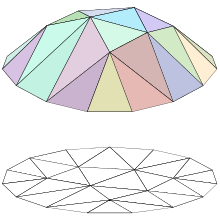
In computational geometry, a polyhedral terrain in three-dimensional Euclidean space is a polyhedral surface that intersects every line parallel to some particular line in a connected set (i.e., a point or a line segment) or the empty set. Without loss of generality, we may assume that the line in question is the z-axis of the Cartesian coordinate system. Then a polyhedral terrain is the image of a piecewise-linear function in x and y variables.
The polyhedral terrain is a generalization of the two-dimensional geometric object, the monotone polygonal chain.
As the name may suggest, a major application area of polyhedral terrains include geographic information systems to model real-world terrains.
Representation
A polyhedral model may be represented in terms of the partition of the plane into polygonal regions, each region being associated with a plane patch which is the image of points of the region under the piecewise-linear function in question.
Problems
There are a number of problems in computational geometry which involve polyhedral terrains.
References
- Cole, Richard; Sharir, Micha (1989). "Visibility problems for polyhedral terrains". Journal of Symbolic Computation. 7 (1): 11–30. doi:10.1016/S0747-7171(89)80003-3.
- ^ Sack, Jörg-Rüdiger; Urrutia, Jorge, eds. (2000). Handbook of Computational Geometry. doi:10.1016/B978-0-444-82537-7.X5000-1. ISBN 978-0-444-82537-7. p. 352